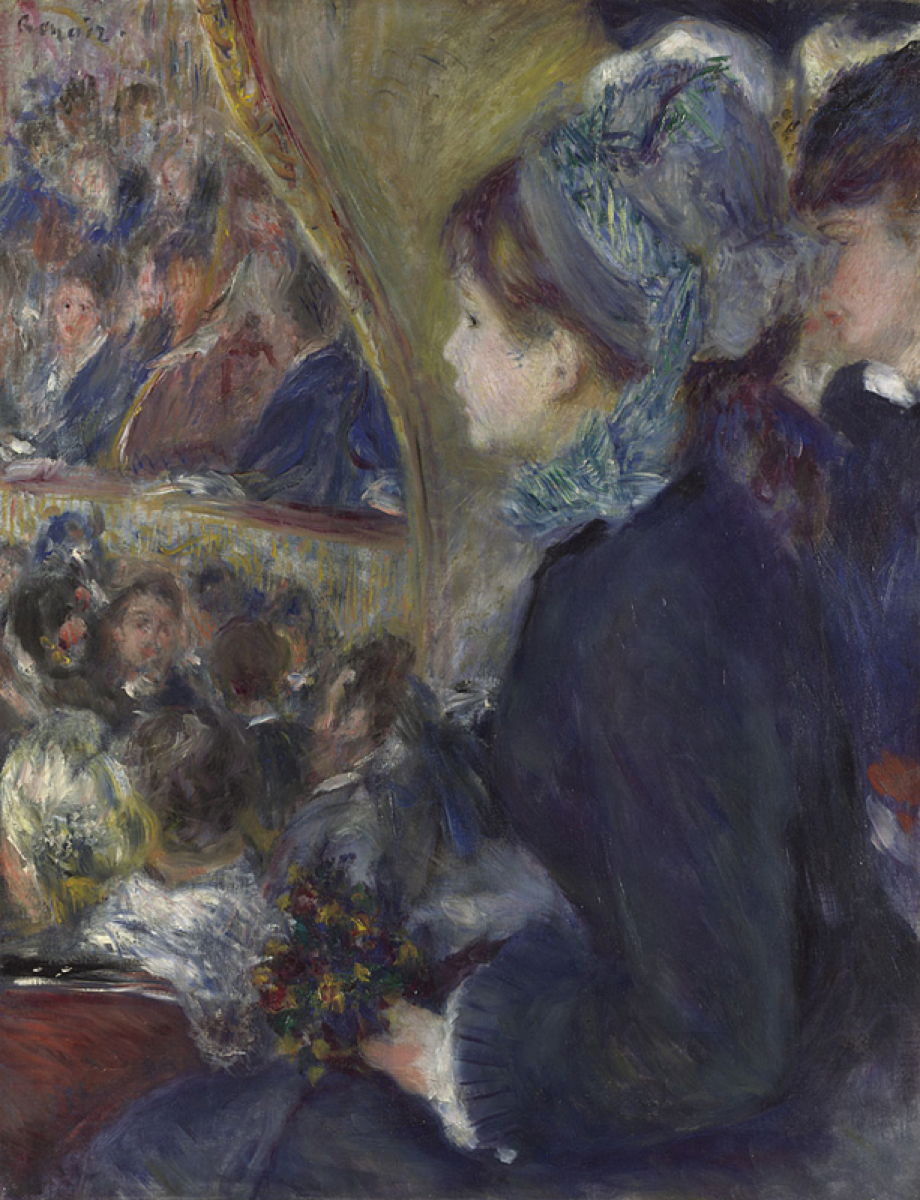In the first of this pair of articles, I looked at a selection of paintings of scenes and people on the stage of the theatre. Today I turn to consider an even stranger topic: the audience (or, more accurately, spectators).
As far as I can discover, the painting which initiated interest in theatre audiences was one of Honoré Daumier’s narrative oil paintings from 1860, which was chosen by Martin Meisel (1983) as a “brilliant” example of narrative painting.

Unusually, the narrative is shown in a stage scene viewed from within (and including) the audience. On stage, a man lies dead, while a woman faces away, showing theatrical body language indicating her distress. Between them a second man points with his left arm down at the corpse, and with his right arm at the woman. But their facial expressions are not seen. In contrast, members of the audience show exaggerated (even theatrical) expressions of shock at the scene in front of them.
As a play within a painting, this deceptively simple image presents a debate between the narrative elements of painting which appears timely in view of the changes which were taking place. It is also worth noting that the play, a tragedy, has reached a moment of peripeteia.
Meisel wrote:
“The figures are faceless and ideal, for it is not their individual passion that counts, but the ensemble. Their facelessness and ideality are appropriate because we are given just the form of the situation, not the specifics of the play.” “It is the audience, one notes, that is marked with individual passions, set into physiognomic masks and – where the reflected light of the stage reveals it – vivid in diversity and character.”
There are other readings too, about us spectating not at reality, but an acting out of an imitation of reality. This is a painting which is, I think, profound, and a far cry from the satires for which Daumier is best-known.

A decade later, Edgar Degas continued his theatrical journey in The Orchestra at the Opera (c 1870), in which the bassoonist closest to the viewer is visibly playing, presumably one the famous bassoon passages from Tchaikovsky’s Swan Lake. He is Désiré Dihau, a friend of the artist and the real subject of this painting, and in the box is the composer Emmanuel Chabrier.

Degas then made the move from the audience and musicians to focus exclusively on the stage and its dancers, with his intermediate pastel painted over a monotype of the Ballet at the Paris Opéra from 1877.
Degas’ friends and collaborators also took an interest in the theatre.

At about the same time, Renoir painted At the Theatre (La Première Sortie) of 1876-7. He has transferred his attention away from the stage, which isn’t even visible, to two young women watching slightly nervously from a box.

Jean-Louis Forain’s watercolour At The Theatre from 1882 goes out of the auditorium altogether to show theatregoers enjoying the social side.
It was the Franco-American Impressionist Mary Cassatt (who learned her printing techniques from Degas) who most developed the theme of women at the theatre.

One of a series of paintings which Cassatt made of women at the theatre, Woman with a Pearl Necklace in a Loge (1879) used her sister Lydia as the model. Cassatt has here used a very sophisticated composition, with extensive reflected images. The woman is seated in front of a mirror, and the whole of the background, apart from the red back of the seat, is seen in reflection. This adds great depth to what would otherwise have been a very tight and close composition.
Cassatt uses these paintings of the theatre to show the New Woman in idealised moments of pleasure – a marked contrast to Degas and others.

Another of her masterpieces of this period, The Loge (c 1878-80) shows two of Cassatt’s friends at the theatre, again using the reflection in a mirror behind them to provide great depth and establish the context. The woman on the left, whose mouth is obscured by her fan, is probably Mary Ellison from Philadelphia, who visited Paris at this time, while the other woman, who could be mistaken for a sister, is thought to have been the daughter of the poet Stephane Mallarmé, who was well-known in contemporary artistic circles.

Using motifs from these paintings, she developed more complex techniques, including the combination of soft-ground, aquatint and etching for her In the Opera Box (No. 3) (c 1880). This was one of a series of prints which she assembled for a journal she had planned with Degas. Then, in April 1880, he withdrew from that project, in a characteristic change of mind.

James Tissot is another artist who painted women in theatre audiences as examples of the New or Modern Woman. After his return to Paris, he included in his successful series of large paintings about the modern woman this view of Women of Sport (The Amateur Circus) from 1883-5. This derivative of the circus seems to have used notable members of the public as its performers, and Tissot places even greater emphasis on audience reaction.

My last painting is another curiosity: it was made by Everett Shinn, a member of the Ashcan School, an American who painted gritty images of the streets of New York and London. He travelled in Europe, apparently seeing works by Degas among others. In the early years of the twentieth century, he painted several scenes in theatres. Among those is The White Ballet from 1904, which continues where Degas had left off.
As with the return of music concerts, nights out at the theatre are something to look forward to.

